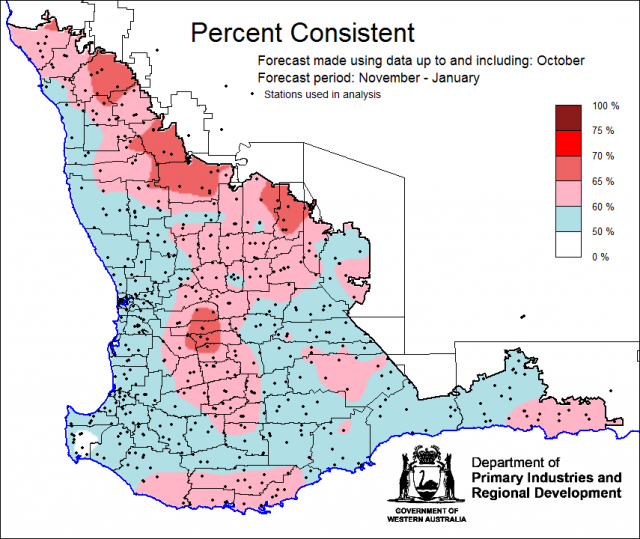Summary
The Department of Primary Industries and Regional Development’s (DPIRD) Statistical Seasonal Forecast (SSF) outlook for November 2020 to January 2021 is 40-80% chance of exceeding median rainfall for the majority of the South West Land Division (SWLD).
- For November 2020 to January 2021, the SSF i is indicating 40-80% chance of exceeding median rainfall for the majority of the SWLD. The higher chances are for the Central West and Central Wheatbelt forecast Districts. For South East Coastal District, parts of the Great Southern and Central Wheatbelt Districts, chances are lower at 20-40%. The most probable rainfall decile map indicates decile 4-7 for the majority of the SWLD. Predictive skill based on October conditions is mostly poor to medium (50-70% consistent).
- The Bureau of Meteorology’s seasonal outlook for November 2020 to January 2021 is indicating 50-80% of exceeding median rainfall for the majority of the SWLD. Predictive skill is poor to good (45-75% consistent). The longer-term outlook for December 2020 to February 2021 gives higher chances at 70-80%. Predictive skill is moderate to good (55-75%).
- Temperature outlooks for November to January 2021, from the Bureau indicate a 65-80% chance of above average day-time maxima along the west coast, with lower chances (30-60%) for the south coast and interior (high skill 75-100%) and 80% chance of above average night-time minima (high skill 65-100%) for the SWLD.
- October rainfall was below average in the SWLD. October maximum and minimum temperatures were very much above average.
- The La Niña in the tropical Pacific Ocean, together with a positive SAM are currently the main climate drivers influencing SWLD climate. In a La Niña, there is an increased chance of above average number of tropical systems (cyclones and lows) across northern Australia. This may lead to more summer rainfall in the SWLD. A positive SAM means westerly winds are further south than normal and this may increase temperatures in the SWLD.
Three Month Outlook for the south-west of Western Australia
Statistical Seasonal Forecasting (SSF)
DPIRD’s Statistical Seasonal Forecast (SSF) system uses historical relationships between global sea surface temperature and sea level pressure with rainfall in south-west Australia to produce forecasts of rainfall for the coming months. Users can click on any station indicated on the map for location-specific forecast information from the Seasonal Climate Information web page.
For November 2020 to January 2021, the SSF is indicating a 40-80% chance of exceeding median rainfall for the majority of the South West Land Division. The higher chances are for the Central West and Central Wheatbelt forecast Districts. For South East Coastal District, parts of the Great Southern and Central Wheatbelt Districts, chances are lower at 20-40%. The most probable rainfall decile map indicates decile 4-7 for the majority of the SWLD. Predictive skill based on October conditions is mostly poor to medium (50-70% consistent).


